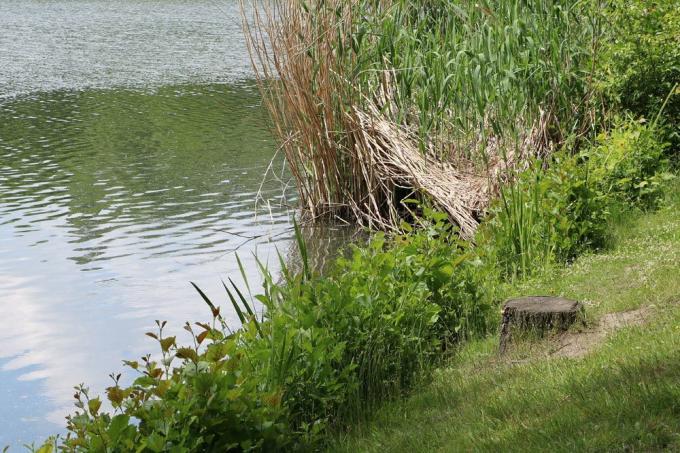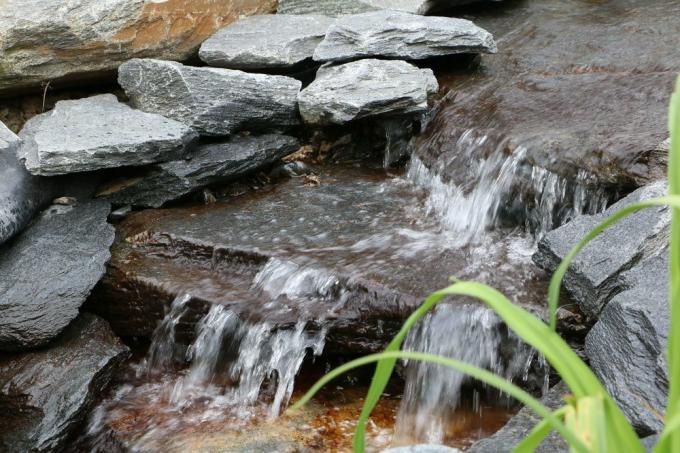
table of contents
- Green water
- Shading
- Muddy water
- Water exchange
- Water purification
- Biological balance
- UVC clarifier
- prevention
- Plant care
A pond with fish and / or decorative water plants is the dream of many garden owners. Thanks to numerous tips on the Internet and a large selection of material in the hardware store, this dream is quite easy to realize. But if the water becomes cloudy and green after a while, the garden pond quickly loses its attraction and attractiveness. However, there is something you can do about it and use very simple means to ensure clear water in the future.
Green water
Why is the water in my garden pond green?
Usually the formation of floating algae or a large amount of duckweed is responsible for the green color of the pond water. Cloudy water, on the other hand, is also caused by digested sludge. Since floating algae can multiply very quickly, you should react as soon as possible if you notice them. Incidentally, the shallower and larger a pond, the more susceptible it is to the formation of algae. In a small but deep pond, significantly fewer algae form with the same amount of water.
Common reasons for algae formation:
- too strong sunlight
- too many nutrients from overfertilization
- Leftovers from fish feed
- too little oxygen

Shading
What can I do about too much sun?
Of course, you cannot influence the weather or move clouds in front of the sun, but there are various ways in which you can shade your garden pond. The quickest way will surely be a parasol that you set up in a suitable place in strong sunshine. However, this umbrella is not a permanent solution, because it would have to be repositioned several times a day so that your garden pond really remains in the shade for a long enough time.
A privacy screen in a suitable place would offer sufficient shade, but it may also hide the unrestricted view of the pond and thus the joy of it. The solution could be a new planting of the edges of your pond. A slightly taller bamboo, for example, provides shade, but does not cause as much foliage as a correspondingly large bush or tree. For this you should definitely build a rhizome barrier around the bamboo, otherwise its long and strong root shoots, the rhizomes, damage the pond liner after a while and a hole cause.
Muddy water
Why is the water in my new garden pond cloudy?
If you have only recently created your garden pond, then cloudy pond water is not a cause for concern. It takes some time for all the suspended particles, sand and pond soil to settle. Then you should have a clear view of the pond floor. However, if the pond water remains permanently cloudy, you should definitely react.
You may have filled the pond with rainwater because it is a cheap and therefore quite popular solution. However, many nutrients are dissolved in rainwater, which then cause algae to form relatively quickly. Well water is also unsuitable as a pond filling, because it is usually poor in oxygen. Well water may also contain iron and / or manganese. This is especially true for deep wells, the water from shallow wells or shaft wells is usually better suited to fill the pond.

Water exchange
Can I exchange green or cloudy pond water?
At first glance, replacing the cloudy pond water appears to be an attractive and simple solution. But unfortunately appearances are deceptive. With a water change, you are more likely to cause damage than to use your garden pond. Because with the fresh water you bring additional nutrients into the pond. This will encourage the formation of algae instead of inhibiting them.
Water purification
How do I get the water clear again?
The first measure against green pond water is to fish off existing algae and / or duckweed. You can use a net or a plastic leaf broom for this. This is also suitable for fishing leaves and other undesirable things from the surface of the water. The use of a UVC clarifier, which removes floating algae, is also helpful. You should only use an algae control agent if neither children nor animals drink from the pond water or play with it. It inhibits the photosynthesis of the algae and lets them "starve".
Biological balance
Ensure the biological balance in the long term
In the medium and long term, you should definitely restore the biological balance of the pond and increase the water quality. This is the only way to prevent the pond water from becoming green or cloudy again and again. With a water analysis set you can check the most important water values. For example, the water hardness, the carbonate hardness, the pH value, the nitrate and nitrite content are important.
These values influence each other. In the event of an imbalance, you can counteract this with the appropriate means and restore the equilibrium. It is best to measure the values in spring or summer during the growth phase of your pond plants. During the vegetation break, the values naturally often deviate from the norm.
Optimal water values:
- pH value (acid-base value): 7 to 8
- KH value (carbonate hardness): 5 to 12
- GH value (water hardness): 8 to 12
- Nitrate: <0.5 mg per liter
- Nitrite: <0.15 mg per liter

UVC clarifier
How does a UVC clarifier work?
A UVC clarifier, also called a pond clarifier, can be placed in front of a pond pump. The pond water sucked in by the pump then also runs through the primary clarifier. This causes the existing floating algae to clump together with UV light so that they can be filtered out. In addition, the radiation should kill various organisms and germs, such as mold, viruses and paramecia. To ensure that the primary clarifier always works properly and as required, you should check the UV lamp regularly and clean it thoroughly if necessary. The lamp lasts about a year, then it has to be replaced.
prevention
How can I prevent green water in the future?
If you want to prevent green and cloudy pond water in the long term, you have already improved the water quality and one If the UVC clarifier is used, but the desired result is still not achieved, you should take further measures seize.
Measures against green and cloudy water:
- Place oxygen-producing plants
- Install filter system
- Save fish feed
- Reduce entry of leaves
- Prevent digested sludge
- Avoid over-fertilization
Make sure you increase the oxygen content in your pond water. So-called oxygen plants excellently prevent the formation of algae and thus green water. Green pennywort or hornwort, for example, are particularly suitable. A filter system also increases the oxygen content in the pond water. If you don't have a filter yet, you should urgently get one now. You should also replace a filter system that is too small with a larger one. Alternatively, you can install a fountain. However, it will only be able to provide sufficient oxygen in a small garden pond.
With a normal fish population, you don't actually have to feed your fish at all. You can find enough food in the pond water. If you still want to feed extra, for example to watch fish, then only give small amounts of fish food. After feeding, no more food should swim in the garden pond. Also make sure that not too many fish live in your pond and also take into account natural reproduction. Because the excrement of your fish also act as fertilizer and can cause digested sludge.

Plant care
Properly care for plants in and around the pond
Fertilize your pond and bank plants only a little to moderate and under no circumstances more than is recommended for the individual plants. If your pond water tends to turn green again and again, you should refrain from using fertilizer for a while. This will certainly not damage your pond plants. Do not start fertilizing again until you notice that your plants are starting to worry, are not growing enough, or are not blooming.
If your garden pond is close to trees, you may stretch a net over the water surface in autumn. This will prevent too much leaves from falling into it. If the amount of leaves is limited, it is sufficient to remove them weekly, so that you also reduce the formation of digested sludge.


